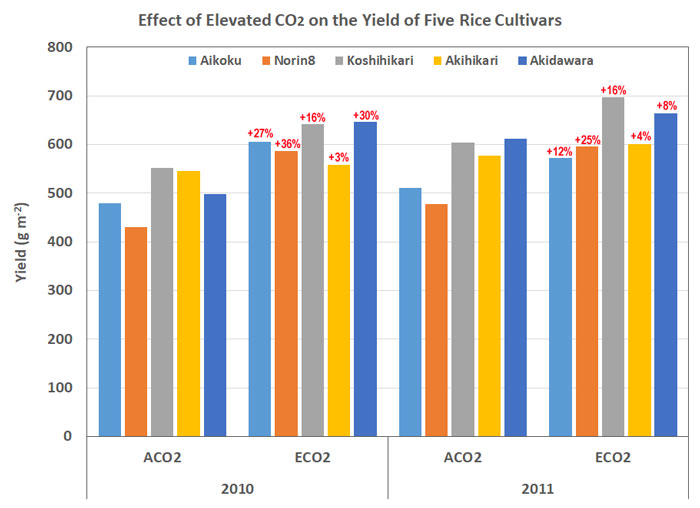| Tweet | Follow @co2science |
Paper Reviewed
Sakai, H., Tokida, T., Usui, Y., Nakamura, H. and Hasegawa, T. 2019. Yield responses to elevated CO2 concentration among Japanese rice cultivars released since 1882. Plant Production Science 22: 352-366.
According to Sakai et al. (2019), increasing atmospheric CO2 concentrations "will offer opportunities to increase crop productivity because CO2 is a substrate for photosynthesis and increases photosynthesis rates" and, hence, yields. Yet they correctly note that "significant intraspecific variation in the yield response to elevated CO2 [has been] found in major food crops." Therefore, they continue, "screening for or breeding elevated CO2-responsive cultivars offers an effective way to adapt crops to global climate change." And so the five Japanese scientists set out to investigate the impacts of elevated CO2 on five key rice cultivars released in Japan since 1882.
The five examined cultivars, with the years of their commercial release following in parentheses, included Aikoku (1882), Norin 8 (1934), Koshihikari (1956), Akihikari (1976) and Akidawara (2009). Samples of each cultivar were grown in the field in 2010 and 2011 in a free-air CO2 enrichment (FACE) environment located in Tsukubanirai City, Ibaraki Prefecture, Japan. The season-long daytime average CO2 concentration in the ambient treatment was 385 ppm in 2010 and 379 ppm in 2011, whereas it was 585 ppm and 560 ppm in the elevated CO2 treatment, respectively.
As shown in the accompanying figure, results of the experiment revealed that under ambient CO2 conditions, the three most recently released rice cultivars (Koshihikari, Akihikari and Akidawara) were approximately 19 percent higher than the two oldest cultivars (Aikoku and Norin 8). Under elevated CO2 conditions, the two-year averaged yields increased by 19.3%, 30.3%, 15.9%, 3.4% and 19.0% for Aikoku, Norin 8, Koshihikari, Akihikari and Akidawara, respectively, indicating that the two earliest cultivars tended to be the most responsive cultivars to atmospheric CO2 enrichment in terms of yield. Nevertheless, elevated CO2 also stimulated other growth parameters across the years and cultivars, including light-saturated net photosynthesis (+27.9%), shoot and root dry weights, total dry weight at heading (+12.8%), total dry weight at maturity (+15.9%), total nitrogen uptake at heading (+4.6%) and maturity (+9.2%), spikelet density (+10.6%), panicle number, spikelets per panicle, percentage of ripened grain and harvest index.
In light of all the above, it is clear that rising atmospheric CO2 will greatly benefit rice yields in the future, which is wonderful news for the approximate one-half of the world's population that consumes this key food crop. And based on the data presented in Figure 1, it would appear that the best of the five introduced Japanese varieties to grow in the future is Koshihikari or Akidaware, which both produced approximately the same yield values under elevated CO2.

Figure 1. Yield of five rice cultivars grown in Japan under ambient (ACO2) or elevated (ECO2) CO2 conditions in the 2010 and 2011 growing seasons. The percentages shown in red text indicate the percent increase in yield for a given cultivar due to CO2 in that growing season. This figure was created using data presented in the authors' Table 4.




